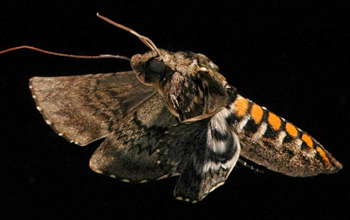Multimedia Gallery
Tobacco Hawk Moth (Sphingidae: Manduca sexta)
A hovering tobacco hawk moth (Sphingidae: Manduca sexta). The moth's wings beat about 25 times a second and considerable deformation of the wings occurs during certain phases of the wing stroke. (Note the S-shaped deformation of the left wing in this picture).
Based on previous studies on insect flight, researchers assumed that insect wings are relatively rigid as they flap. But research by Andrew Mountcastle, a doctoral student in biology at the University of Washington (UW), used high-speed digital imaging to show that, at least for some insects, wings that flex and deform--similar to what happens to a heavy beach towel when you snap it to get rid of the sand--are best for staying aloft. "The evidence indicates that flexible wings are producing profoundly different air flows than stiff wings, and those flows appear to be more beneficial for generating lift," said Mountcastle.
Mountcastle used particle image velocimetry, a technique commonly used to determine flow velocities in fluids, to study how air flowed over the wings of the tobacco hawk moth. The method combined laser light and high-speed digital video to model air flow.
To learn more about this research, which was funded in part by a grant from the National Science Foundation, see the UW news story Straighten Up and Fly Right: Moths Benefit More From Flexible Wings Than Rigid. (Date of Image: January 2006)
Credit: Armin Hinterwirth, University of Washington
See other images like this on your iPhone or iPad download NSF Science Zone on the Apple App Store.
Images and other media in the National Science Foundation Multimedia Gallery are available for use in print and electronic material by NSF employees, members of the media, university staff, teachers and the general public. All media in the gallery are intended for personal, educational and nonprofit/non-commercial use only.
Images credited to the National Science Foundation, a federal agency, are in the public domain. The images were created by employees of the United States Government as part of their official duties or prepared by contractors as "works for hire" for NSF. You may freely use NSF-credited images and, at your discretion, credit NSF with a "Courtesy: National Science Foundation" notation.
Additional information about general usage can be found in Conditions.
Also Available:
Download the high-resolution JPG version of the image. (230 KB)
Use your mouse to right-click (Mac users may need to Ctrl-click) the link above and choose the option that will save the file or target to your computer.

